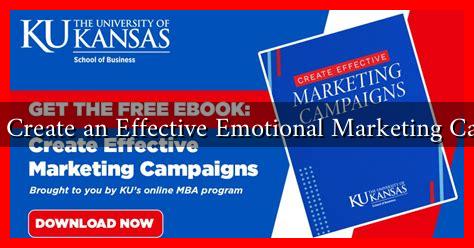-
Table of Contents
How to Create an Effective Emotional Marketing Campaign
In today’s competitive marketplace, brands are constantly seeking innovative ways to connect with their audience. One of the most powerful tools at their disposal is emotional marketing. By tapping into the feelings and emotions of consumers, brands can create campaigns that resonate deeply, foster loyalty, and drive sales. This article will explore how to create an effective emotional marketing campaign, supported by examples, case studies, and statistics.
Understanding Emotional Marketing
Emotional marketing is the practice of using emotions to influence consumer behavior. It goes beyond traditional marketing strategies that focus solely on product features and benefits. Instead, emotional marketing aims to create a connection between the brand and the consumer by appealing to their feelings. According to a study by the American Marketing Association, emotional responses to advertisements can significantly impact consumer decision-making, often more than rational responses.
Key Elements of an Effective Emotional Marketing Campaign
Creating an emotional marketing campaign involves several key elements:
- Identify Your Audience: Understanding your target audience is crucial. Conduct market research to identify their demographics, preferences, and emotional triggers.
- Choose the Right Emotion: Different emotions can evoke different responses. Common emotions used in marketing include happiness, sadness, fear, and nostalgia. Choose an emotion that aligns with your brand message.
- Craft a Compelling Story: Storytelling is a powerful tool in emotional marketing. Create a narrative that resonates with your audience and evokes the chosen emotion.
- Utilize Visuals: Images and videos can enhance emotional appeal. Use visuals that complement your story and evoke the desired emotional response.
- Engage with Authenticity: Authenticity is key in emotional marketing. Ensure that your message aligns with your brand values and is genuine to avoid backlash.
Examples of Successful Emotional Marketing Campaigns
Several brands have successfully implemented emotional marketing campaigns that have left a lasting impact:
- Always – #LikeAGirl: This campaign challenged gender stereotypes and empowered young girls. By showcasing the strength and confidence of girls, Always connected emotionally with its audience, resulting in increased brand loyalty and sales.
- Google – Year in Search: Google’s annual recap of the year’s most searched topics often evokes nostalgia and reflection. By highlighting significant global events and personal stories, Google creates an emotional connection with its users.
- Apple – Misunderstood: This holiday ad tells the story of a teenager who appears disengaged but ultimately reveals a heartfelt surprise. The ad resonates with viewers, showcasing the importance of family and connection during the holidays.
Measuring the Success of Your Campaign
To determine the effectiveness of your emotional marketing campaign, consider the following metrics:
- Engagement Rates: Monitor likes, shares, and comments on social media platforms to gauge audience engagement.
- Brand Sentiment: Use sentiment analysis tools to assess how consumers feel about your brand before and after the campaign.
- Sales Data: Track sales figures during and after the campaign to measure its impact on revenue.
- Customer Feedback: Collect feedback through surveys or focus groups to understand how the campaign resonated with your audience.
Conclusion
Creating an effective emotional marketing campaign requires a deep understanding of your audience, a clear emotional message, and authentic storytelling. By leveraging the power of emotions, brands can foster stronger connections with consumers, leading to increased loyalty and sales. As demonstrated by successful campaigns from brands like Always, Google, and Apple, emotional marketing can be a game-changer in today’s competitive landscape. Remember to measure the success of your campaign to refine your strategies for future endeavors. By following these guidelines, you can create an emotional marketing campaign that not only resonates with your audience but also drives meaningful results.


